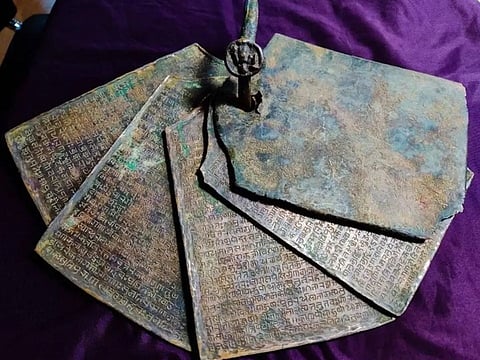

A set of copper plates dating back to the early 15th century from the reign of Devaraya I of the Sangama Dynasty have been unveiled by the Falcon Coins Gallery in Bengaluru and the Archaeological Survey of India (ASI).
These copper plates, which are “tied” together by a copper ring, belong to the Vijayanagara Empire and are written in Sanskrit, Kannada and Nāgarī characters. What makes them unique is that they were issued during the coronation of King Devaraya I. Notably, the seal features an image of Vamana instead of the customary Varaha, the royal insignia of the Vijayanagara Empire.
The copper plates, dating back to November 5, 1406, provide a detailed genealogy of the Sangama Dynasty. According to an ASI official, they trace the lineage from Chandra, Yadu and Sangama to his five sons: Harihara, Kampa, Bukka, Mãrapa and Muddapa. The plates record that King Devaraya I, son of Harihara, granted the village of Gudipalli—along with two hamlets, Rājēndramāda and Udayapalli—during his coronation.
The village was renamed Devaräyapura-agrahāra and divided into 61 shares distributed among several Brahmins of various gotras and sutras who were well-versed in the Vedas and shastras. The allocation included 26.5 shares to Rigvedins, 29.5 shares to Yajurvedins, three shares to Shukla-Yajurvedins, and two shares as Dēvabhāga to Somanatha (Shiva) and Janardhana. The grant’s boundaries, situated in Mulbāgil rājya, Hodēnāda-sthala, are detailed in the Kannada language.
The Falcon Coins Gallery procured three sets of copper plates from a numismatics collector last month. Its manager said that upon discovering the plates, they immediately informed the ASI, which took imprints for study.
By generating estampages—paper impressions of the inscriptions—the ASI team is deciphering the other two sets: a 7th-century set of two plates with a bull emblem and engravings in Brahmi, belonging to the Maitrakas; and a 14th-century set of five plates in Hale Kannada, with an elephant emblem, belonging to the Western Ganges. The second set has a half-broken plate.
(With inputs from multiple news reports)
